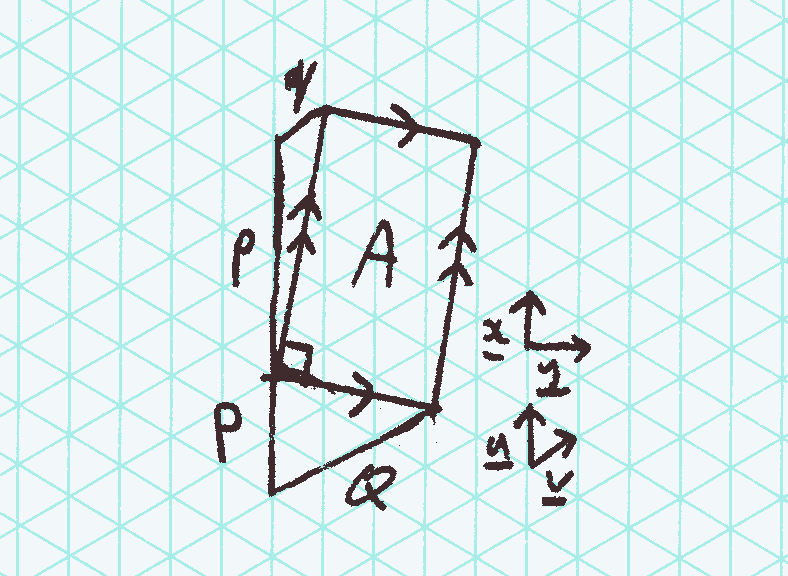Rectangles on a triangular lattice
Starting from this post I'll be using MathJax to display prettier equations. It does require Javascript, but it's much less awkward than the alternatives I've considered.

I was wondering about drawing rectangles on a regular triangular lattice. I found that the area is always a multiple of 4 cells.
Let \(\mathbf{u},\mathbf{v}\) be the basis vectors of the triangular lattice, and \(\mathbf{x},\mathbf{y}\) be the basis vectors of rectangular Cartesian coordinates. Specify a point on the lattice by \(p,q \in \mathbb{Z}\), then:
\[ p \mathbf{u} + q \mathbf{v} = (p + \frac{q}{2}) \mathbf{x} + \frac{\sqrt{3}}{2} q \mathbf{y} \]
with the squared Euclidean distance of the point from the origin being:\[ \left|\left| p \mathbf{u} + q \mathbf{v} \right|\right| ^ 2= p^2 + q^2 + pq \]
Now assume \(\gcd(p,q) = 1\), to ensure that the line segment from the origin to the point passes through no other lattice points. A line \((P,Q)\) perpendicular to \((p,q)\) satisfies:
\[ (p + \frac{q}{2}) \mathbf{x} + \frac{\sqrt{3}}{2} q \mathbf{y} = \lambda ( -\frac{\sqrt{3}}{2} Q \mathbf{x} + (P + \frac{Q}{2}) \mathbf{y} ) \]
which reduces to
\[ \frac{P}{Q} = - \frac{p + 2 q}{2 p + q} \]
Letting \(K = \gcd(p + 2 q, 2 p + q)\), then \(P = -\frac{p + 2 q}{K}\) and \(Q = \frac{2 p + q}{K}\) and \(\gcd(P,Q) = 1\).
The area of the rectangle can be found in terms of \(p\) and \(q\):
\[ A^2 = (p^2 + q^2 + pq) (P^2 + Q^2 + PQ) \]
which reduces to
\[ A = \sqrt{3} \frac{p^2 + q^2 + pq}{K} \]
Expressing this in terms of the smallest triangular cell on the lattice, which has area \(\frac{\sqrt{3}}{4}\), gives a count of triangles:
\[ N = 4 \frac{p^2 + q^2 + pq}{K} \]
Recall that \(\gcd(p,q) = 1\) and \(\gcd(p + 2 q, 2 p + q) = K\). This means that \(K \mid p + 2 q\) and \(K \mid 2 p + q\) which implies that \(K \mid 3 (p + q)\). So \(K \mid 3 \) or \(K \mid p + q\). When \(K\) doesn't divide \(p + q\) then \(K \in \{1,3\}\). Suppose \(K \mid p + q\), then \(K \mid p + 2 q\) implies that \(K \mid q\), and similarly \(K \mid 2 p + q\) implies that \(K \mid p\). But \(\gcd(p,q) = 1\), therefore \(K = 1\).
\(K = 1\) implies that \(4 \mid N\), so it remains to consider the other case when \(K = 3\). Let \(p = 3 a + b\) and \(q = 3 c + d\) with \(b,d \in \{0,1,2\}\). Now \(K \mid b + 2 d\) and \(K \mid 2 b + d\). Exhaustive case analysis shows that this holds only when \(b = d\). Expanding
\[ p^2 + q^2 + pq = 3(\ldots) + b^2 + d^2 + bd = 3(\ldots) + 3 b^2 \]
shows that \(3 \mid p^2 + q^2 + pq\). So \(\frac{p^2 + q^2 + pq}{K}\ \in \mathbb{Z}\) and \(4 \mid N\): the area of a rectangle on a triangular lattice is always a multiple of 4 cells.